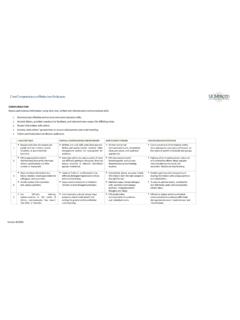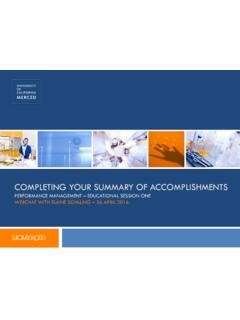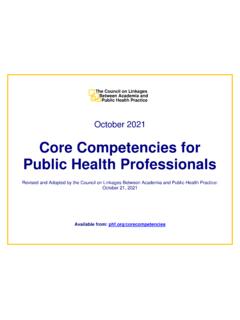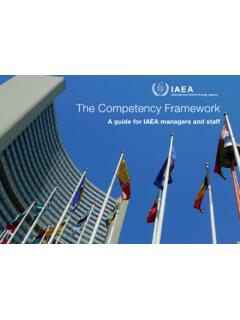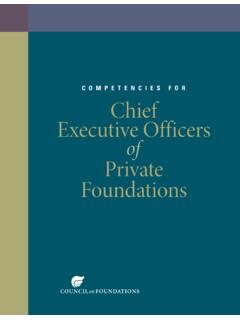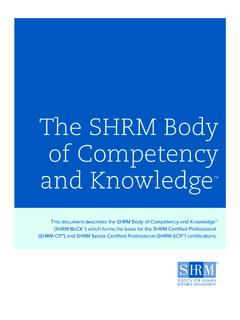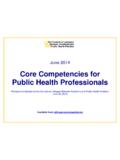Transcription of CORE COMPETENCIES AND THEIR ROLE IN PERFORMANCE …
1 core COMPETENCIES AND THEIR ROLE IN PERFORMANCE . APPRAISALS. PERFORMANCE MANAGEMENT EDUCATIONAL SESSION ONE. WEBCHAT WITH ELAINE SCHILLING 3 MAY 2016. core COMPETENCIES and THEIR role in PERFORMANCE appraisals An overview of core COMPETENCIES and how they are used in PERFORMANCE appraisals What is a Competency? It is a measurable pattern of skills, knowledge, abilities, behaviors and other characteristics needed to perform and fulfill one's job responsibilities. core COMPETENCIES COMPETENCIES are important for: Ensuring organizational success Enhancing employee contribution, PERFORMANCE Measuring job responsibilities and organizational citizenship behaviors, such as communication, teamwork and collaboration Illustrating two important factors: how well you perform your job and how well you perform your job in a team environment Effects of Using core COMPETENCIES Organizational results Individual results ( PERFORMANCE ).
2 Behaviors COMPETENCIES Competency-based PERFORMANCE Management Addresses how a person accomplishes job responsibilities in addition to what a person accomplishes. Focus on both How What COMPETENCIES organizational Job responsibilities citizenship behaviors UC Merced core COMPETENCIES 1. Communication 2. Diversity and inclusion 3. Employee engagement They speak to the skills 4. Innovation and change management and behaviors 5. Job mastery and continuous learning necessary for personal 6. Resources management and sustainability and professional 7. Results orientation and execution success. 8. Service focus All employees should 9. Teamwork and collaboration demonstrate each of 10. Solving problems these COMPETENCIES in 11. Quality assurance and assessment THEIR day-to-day tasks and job responsibilities. 12. People management (for managers).
3 UC Merced core COMPETENCIES 1. Communication 2. Diversity and inclusion 3. Employee engagement 4. Innovation and change management Halogen PERFORMANCE Appraisal 5. Job mastery and continuous learning 6. Resources management and sustainability 7. Results orientation and execution 8. Service focus 9. Teamwork and collaboration 10. Solving problems 11. Quality assurance and assessment 12. People management (for managers). UCM core COMPETENCIES Rubric Guide Provides examples of what behaviors could look like and are not inclusive of all behaviors that demonstrate each level of PERFORMANCE for the competency. The rubric is a tool to help guide evaluation of employee PERFORMANCE and should not be used as a checklist for employees' behavior. It is important to have discussions in your area/unit, so that each person understands what each competency looks like on a regular basis and how PERFORMANCE is being assessed.
4 UCM core Competency - Example DIVERSITY AND INCLUSION. Description: Models and promotes UCM's Principles of Community and complies with UC. Policies on Diversity and Non-Discrimination. 1. Demonstrates behaviors that include fairness, respect, inclusiveness, empathy, integrity, and ethical conduct. 2. Fosters a climate and culture in which each person is accepted and has the opportunity to grow and develop. 3. Practices behaviors that promote diversity and inclusion in dealings with and on behalf of the University, consistent with laws, regulations, UC Policies, and Principles of Community. core Competency Example Diversity and Inclusion (behavioral indicators). Unacceptable (U) Partially meets/needs Meets expectations Far exceeds improvement (NI) (ME) expectations (FE). 1 Does not demonstrate Is often not aware of or Respects, includes, and Highly inclusive.
5 Inclusiveness; fails to interested in diverse recognizes differences. encourages, recognize the value of backgrounds or points recognizes and differences. of view. incorporates diverse points of view. 2 Is not welcoming or Is reticent to include Includes and welcomes Actively creates an respectful; coworkers new people or ideas. diverse individuals and inclusive and and campus partners groups. welcoming often work around to environment for avoid interaction. diverse individuals and groups across campus. 3 Neither understands Needs to develop better Participates in a range Actively creates nor promotes understanding and of opportunities to opportunities for opportunities to awareness of learn about and others to learn about experience diversity on opportunities to learn experience diversity on and experience campus. about and experience campus; encourages diversity on campus.
6 Diversity on campus. others to do the same. core Competency Example Diversity and Inclusion (behavioral indicators). Meets expectations (ME). 1 Respects, includes, and recognizes differences. In the project assignment to survey student users about THEIR IT needs for the next year, XXX defined the different levels of users he had worked with this past year (beginner to advanced.) He met with each group to determine what they needed. 2 Includes and welcomes diverse individuals and groups. When talking with users, he individually welcomed and thanked each person and each group. He did not assume that he knew THEIR needs; he gave them the opportunity to describe THEIR needs. He was respectful of the large range of user knowledge by indicating there was no right or wrong level of knowledge. 3 Participates in a range of opportunities to learn about and experience diversity on campus; encourages others to do the same.
7 As part of this project, he responded to one immediate need and had a user job aid translated into two languages. He sought out colleagues who had worked with similar student users during the past year - he asked questions, listened to THEIR lessons learned, and borrowed successful strategies. At the end of the project, he encouraged his peers to go out and learn first hand about who our diverse users are, and what THEIR diverse needs are.. Benefits of Using COMPETENCIES For managers For employees Clarify standards of PERFORMANCE Criteria required to be successful for easier communication of in the job are identified and expectations to direct reports. described. Provide foundation for Provide foundation for dialogue with employee about dialogue with supervisor about PERFORMANCE , development, and PERFORMANCE , development, and career related issues.
8 Career related issues. Identify PERFORMANCE criteria to Identify specific areas for improve the accuracy and ease of professional development and/or observing, discussing and improvement, career goals. evaluating PERFORMANCE . How Supervisors Can Use COMPETENCIES Set and Communicate Clear Clarify job standards, expectations Expectations Provide employees with clear direction on how they can contribute to the University Reinforce behaviors that are consistent with the University's mission, culture, and priorities Identify Provide employees with a roadmap for building strengths Learning & and closing development gaps Development Tie to career growth and encourage an organizational Actions culture that values and pursues learning Prepare employees to succeed in changing work world Manage Improve consistency in recruiting and selection, training, Human PERFORMANCE management, talent management and Resources workforce planning Streamline and simplify HR operations.
9 Responsibilities of supervisors How Individuals Can Use COMPETENCIES Set and Partner with supervisor to set expectations Understand Understand and meet job standards, expectations Expectations Understand how I contribute to the University's success Employ behaviors that are consistent with the University's mission, purpose, and culture Identify Develop a roadmap for building my strengths and Learning & closing development gaps Development Tie to career growth and on-going learning Actions Develop skills and knowledge to succeed in changing work world Recognize that I have transferable skills Match experience and knowledge with core COMPETENCIES Use of COMPETENCIES Example: Employee Development Communication: Development Actions On the job Prepare for difficult interaction by conducting a mock/role play session;. practice listening and asking questions Shadow senior colleagues as they prepare for and /or deliver high visibility presentations Debrief after receiving feedback; give/accept honest feedback and apply key learning points Practice identifying and adapting to a range of specific communication styles; seek input from colleagues on best practices and what works in the UCM culture Coaching/ Sit in (or listen in) with more senior colleagues in meetings; summarize mentoring observations and implications for how to improve personal communication style Ask for feedback on writing before submitting to manager Seek feedback from your manager on how to handle a challenging employee issue ( , strong performer who does not work well with peers).
10 Take action and follow up Formal Take a writing skills course training Take a training course ( , listening skills, reading body language, asking effective questions, negotiation skills). Upcoming Webchat Join us on the next webchat, scheduled for: Wednesday, May 18 from 2:30 to 3:30. Establishing Meaningful Goals . core COMPETENCIES AND THEIR ROLE IN PERFORMANCE . APPRAISALS. PERFORMANCE MANAGEMENT EDUCATIONAL SESSION ONE. WEBCHAT WITH ELAINE SCHILLING 3 MAY 2016.
